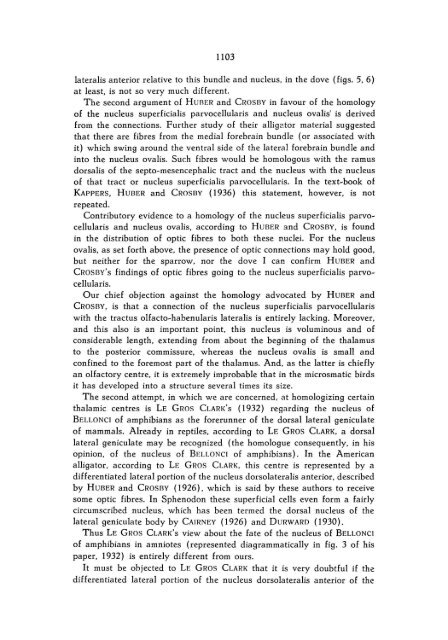The nucleus of BELLONCI in birds - DWC
The nucleus of BELLONCI in birds - DWC
The nucleus of BELLONCI in birds - DWC
Create successful ePaper yourself
Turn your PDF publications into a flip-book with our unique Google optimized e-Paper software.
1103<br />
lateralis anterior relative to th is bundIe and <strong>nucleus</strong>. <strong>in</strong> the dove (figs. 5. 6)<br />
at least. is not so very mueh different.<br />
<strong>The</strong> seeond argument <strong>of</strong> HURER and CROSBY <strong>in</strong> favour <strong>of</strong> the homology<br />
<strong>of</strong> the <strong>nucleus</strong> superficialis parvoeellularis and <strong>nucleus</strong> ovalis' is derived<br />
from the eonneetions. Further study <strong>of</strong> their allig2tor material suggested<br />
that there are fibres from the media I forebra<strong>in</strong> bundIe (or assoeiated with<br />
it) which sw<strong>in</strong>g around the ventral side <strong>of</strong> the lateral forebra<strong>in</strong> bundIe and<br />
<strong>in</strong>to the <strong>nucleus</strong> ovalis. Sueh fibres would be homologous with the ramus<br />
dorsalis <strong>of</strong> the septo-meseneephalic traet and the <strong>nucleus</strong> with the <strong>nucleus</strong><br />
<strong>of</strong> that traet or <strong>nucleus</strong> superficialis parvoeellularis. In the text-book <strong>of</strong><br />
KAPPERS. HUBER and CROSBY (1936) this statement. however. is not<br />
repeated.<br />
Contributory evidenee to a homology <strong>of</strong> the <strong>nucleus</strong> superficialis pa rvoeellularis<br />
and <strong>nucleus</strong> ovalis. aeeord<strong>in</strong>g to HUBER and CROSBY. is found<br />
<strong>in</strong> the distribution <strong>of</strong> optie fibres to both these nuclei. For the <strong>nucleus</strong><br />
ovalis. as set forth above. the presenee <strong>of</strong> optie connections may hold good.<br />
but neither for the sparrow. nor the dove I ean eonfirm HUBER and<br />
CROSBY's f<strong>in</strong>d<strong>in</strong>gs <strong>of</strong> optie fibres go<strong>in</strong>g to the <strong>nucleus</strong> superficialis pa rvoeellularis.<br />
Our ehief objection aga<strong>in</strong>st the homology advoeated by HUBER and<br />
CROSBY. is that a connection <strong>of</strong> the <strong>nucleus</strong> superficialis parvoeellularis<br />
with the tractus olfaeto-habenularis lateralis is entirely lack<strong>in</strong>g. Moreover.<br />
and this also is an important po<strong>in</strong>t. th is <strong>nucleus</strong> is volum<strong>in</strong>ous and <strong>of</strong><br />
eonsiderable length. extend<strong>in</strong>g from about the beg<strong>in</strong>n<strong>in</strong>g <strong>of</strong> the thalamus<br />
to the posterior commissure. whereas the <strong>nucleus</strong> ovalis is small and<br />
eonf<strong>in</strong>ed to the foremost part <strong>of</strong> the thalamus. And. as the latter is ehiefly<br />
an olfaetory centre. it is extremely improbable that <strong>in</strong> the mierosmatie <strong>birds</strong><br />
it has developed <strong>in</strong>to a strueture several times its size.<br />
<strong>The</strong> seeond attempt. <strong>in</strong> which we are concerned. at homologiz<strong>in</strong>g eerta<strong>in</strong><br />
thalamic centres is LE GROS CLARK's (1932) regard<strong>in</strong>g the <strong>nucleus</strong> <strong>of</strong><br />
<strong>BELLONCI</strong> <strong>of</strong> amphibians as the forerunner <strong>of</strong> the dorsal lateral genieulate<br />
<strong>of</strong> mammals. Already <strong>in</strong> reptiles. aeeord<strong>in</strong>g to LE GROS CLARK. a dorsal<br />
lateral genieulate may be reeognized (the homologue eonsequently. <strong>in</strong> his<br />
op<strong>in</strong>ion. <strong>of</strong> the <strong>nucleus</strong> <strong>of</strong> <strong>BELLONCI</strong> <strong>of</strong> amphibians). In the American<br />
alligator. aeeord<strong>in</strong>g to LE GROS CLARK. this centre is represented by a<br />
differentiated lateral portion <strong>of</strong> the <strong>nucleus</strong> dorsolateralis anterior. described<br />
by HUBER and CROSBY (1926). which is said by these authors to reeeive<br />
some optie fibres. In Sphenodon these superficial eells even form a fairly<br />
cireumseribed <strong>nucleus</strong>. whieh has been termed the dorsal <strong>nucleus</strong> <strong>of</strong> the<br />
lateral geniculate body by CAIRNEY (1926) and DURWARD (1930).<br />
Thus LE GROS CLARK's view about the fate <strong>of</strong> the <strong>nucleus</strong> <strong>of</strong> <strong>BELLONCI</strong><br />
<strong>of</strong> amphibians <strong>in</strong> amniotes (represented diagrammatieally <strong>in</strong> fig. 3 <strong>of</strong> his<br />
paper. 1932) is entirely different from ours.<br />
It must be ohjeeted to LE GROS CLARK that it is very doubtful if the<br />
differentiated lateral portion <strong>of</strong> the <strong>nucleus</strong> dorsolateralis anterior <strong>of</strong> the
















